
A Plum Race
This past Friday the curtain went up on Act I of Fizz World Cup 2009.
Bea Woodget’s touch was evident everywhere, and the organization and execution of the first round of races in Plum Gut was flawless in its detail. Even the sims behaved; the races I attended were low lag, with mercifully quiet border cossings and few crashes within the competition fleet.
This is the second year for the Fizz Cup, and
Bea’s goal this year is to develop a World Cup regatta infrastructure that could expand into other one design classes and serve as a template for future, major sailing competitions. It’s a
great idea, and you can see the elements of this longer strategy throughout the Cup’s
Notice of Race and in Bea’s thread on
SLSailing.org.
 The excitement over this year’s Fizz Cup has been pretty electric in recent weeks, and the registration for the competition broke all past records for a sailing event; over the next several weeks 60 sailors will compete with each other in the initial series of qualifying races hosted by many of the Second Life yacht clubs. Those skippers that emerge victorious from that grueling ordeal will then face each other in “Silver” or “Gold” final rounds that will determine which sailors take home the cup for 2009.
The excitement over this year’s Fizz Cup has been pretty electric in recent weeks, and the registration for the competition broke all past records for a sailing event; over the next several weeks 60 sailors will compete with each other in the initial series of qualifying races hosted by many of the Second Life yacht clubs. Those skippers that emerge victorious from that grueling ordeal will then face each other in “Silver” or “Gold” final rounds that will determine which sailors take home the cup for 2009.
The qualifying series will follow a format similar to Fizz Cup 2008. However, if you think this year’s regatta will be anything like last year, you may want to think again! Friday’s remarkable sailing performance by the fleet in Plum Gut was nothing like last year’s racing for one, huge huge reason: this year’s cup skippers are sailing Mothgirl Dibou’s newly-released Fizz 3.
Fizz Ontology
The Flying Fizz first hit the water in second life in January, 2008. Even before its launch, however, Moth’s little racing dinghy had captured everyone’s attention. It was a major advance over the venerable Tako, and one of the first sailboats designed completely independent of Kanker Greenacre’s sailing scripts. The Flying Fizz wasn’t just a “Tako makeover;” it was a qualitative leap forward that gave the sailing community a glimpse of the future.
That early version of the Fizz changed over time. As with any radical innovation, following it’s initial release the boat went through a blizzard of quick bug fixes and upgrades, and in some ways the boat was still a work-in-progress during the World Cup 2008 race series that took place that Spring. I am not complaining about the Fizz 2.x, however; that earlier boat captured the heart and imagination of the sailing community, and the 2008 Cup drew us together.
A large fleet of skippers participated in the 2008 qualifying rounds , and they sailed Fizz 2.x’s with a skill that approached joyous audacity. The term “Fizz Fanatic” became part of the SL lexicon and was hardly an exaggeration. Last year’s Cup was was was a roaring success, and the largest and most diverse sailboat competition in Second Life history up to that point. The Fizz 2 was a big part of that achievement.
 Having said that, as I watched the Cup 2008 races and tried to reconstruct the tactics employed by the many skippers, I was impressed that Fizz2 still had a ways to go before it accurately modelled small boat racing. Many of the strategies skippers used in the competition were not RL race strategies. Sailors often chose tactics that played off the unique features of the new boat, or exploited “bugs” to enhance their performance rather than focus on sailing skills. The most obvious demonstration of this point occurred early in the series, when it became clear that a number of sailors were legally using a design glitch (pumping the tiller) to go faster. Moth fixed the problem and upgraded all the skippers in the middle of the race series.
Having said that, as I watched the Cup 2008 races and tried to reconstruct the tactics employed by the many skippers, I was impressed that Fizz2 still had a ways to go before it accurately modelled small boat racing. Many of the strategies skippers used in the competition were not RL race strategies. Sailors often chose tactics that played off the unique features of the new boat, or exploited “bugs” to enhance their performance rather than focus on sailing skills. The most obvious demonstration of this point occurred early in the series, when it became clear that a number of sailors were legally using a design glitch (pumping the tiller) to go faster. Moth fixed the problem and upgraded all the skippers in the middle of the race series.
I think the newness of the boat and it’s many features had a somewhat paradoxical impact. On one hand there was no question that the Flying Fizz was a major advance over the Tako, with user features and performance designed intended to make the racing experience much more like real life. However, if you go back and watch the Tako Cup 2007 videos, one can make an argument that the Tako races actually came closer to real-life competition, emphasizing sailing knowledge and strategy.
Boat Handling vs Sailing
In real life sailboat races, the skippers jockey their boats for position with each other, using and often pushing the Rules to gain advantage. It’s not about the boat per se; it’s about sailing. In that spirit, Tako Cup races involved frequent protest calls, and many of those issues and discussions where pretty identical to what any sailor hears at a RL regatta. The emphasis on strategy and tactics was clearly present during the Tako Cup pre-starts too, where skippers jockeyed for an advantageous start position so intensely that the Cup committee approved optional real-life start procedures to ensure a fair race.
In contrast, the Fizz Cup 2008 competition often seem to focus more on a skippers ability to handle the complex boat and maximize its performance; it was more about the boat than about sailing. I know many people might disagree with that assessment, but I think that interpretation partially explains why Fizz skippers made far fewer penalty calls in their Cup races last year compared to their Tako counterparts. It may also explain why many Fizz sailors essentially abandoned the usual dueling that typically characterizes the pre-start of a race. During those two minutes, the Fizz skippers frequently sailed a short distace back, neatly lined up their boats and read the newspaper, waiting for the precise moment to turn on the gas and make an all-out run for the startline. I’ve never seen that strategy in RL.
Please, I’m not complaining. The races were exciting, and the competition showcased the zeal, intelligence and ability of a race fleet drawn from all corners of the SL grid, manned by sailors from RL locations that spanned the Globe. The Fizz 2 platform demonstrated its value, and gained wide popularity and acceptance as SL’ s most advanced one-design standard for small boat racing. However, although Fizz 2.x was a pretty marvelous technical achievement, it still fell short of the goal to construct a progressively more accurate emulation of real-life sailboat racing. I’m sure that Mothgirl Dibou would phrase it differently, but it’s my understanding she saw this problem too. She took all the feedback and observations fromseveral months of Fizz2 racing… and went back to the drawing board. Eight months later, Fizz3 was born.

Fizz2009 Plum Gut Racecourse
Now We are Three
Fizz3 is far, far more than a technical upgrade to last year’s boat. In many ways, it’s another quantal leap ahead. Moth didn’t just make another technical tour de force; she went beyond that, designing a dinghy that responds to the concerns I listed above and incorporates the perception, handling, and the “feel” of a real-life raceboat. Those issues go way beyond “scripting.” I don’t know quite how she did it, but I suspect it has something to do with sweat, toil, frustration – and Moth’s love for the project. The new Fizz3 is another big step in sailboat development, and the boat is so alive and real that many sailors have flip-flop intense reactions to it, sometimes wanting to hug and kiss the boat… while at other times in frustration wanting to drive a wooden stake through the boat’s heart. (Grin… just like real life sailing!)
I’m telling you this story because Fizz Cup 2009 is sailing the new Fizz 3. The races promise to be radically different then we witnessed last year, and the comparison will be fascinating. Last Friday in Plum Gut we got a look at the opening act, the Fizz 3’s debut in Cup competition.
That list of whiny compaints I made about the 2.x above? Well, forget ’em. The races on Friday were way beyond a technically sophisticated computer game. On Friday those skippers were sailing. It was pretty wonderful. Let me tell you about it.

shinobi Woodget gives the fleet a free lesson.
I only have time to tell you about the very first race in any detail, but for me that race tells the whole story about how this competition is shaping up, and why it’s different.
Tim Warrhol, macro Nacht, shinobi Woodget, Odissey Rossini and Alain Gloster all matched wits and sailing ability in that race heat, sailing a simple upwind/downwind sausage-shaped course. The first figure above shows the race start, and from the first moment all those watching could tell this regatta would be very different from 2008. As you can see above, during the countdown the competition fleet actively milled behind the line, aggressively vying for position and advantage over each other. Tim Warrhol got so excited he hit the line several seconds early, and capsized while steering strongly away. He made a rapid recovery, however, and never fell any distance behind the pack.
The second frame above shows shinobi Woodget in the lead a few moments later, followed by macro Nacht and Odissey Rossini. They are all lined upon starboard tack, beating to windward. Shinobi is slightly lee of the other boats, a good strategic position crossing the line but riskier on this first leg if another boat gets close enough to shadow. Luckily that wasn’t the case, and the image below shows the fleet following the first tack, now all on Port. Macro’s in the lead below, but that’s deceptive. Shinobi is following a more windward line and ‘has the height’ to give her better control approaching the yellow mark.

As shown in the Top Mark figure below, she plays it beautifully, stealing macro’s wind and falling off just enough to kiss the yellow buoy and leave it to port. Her setup is so good she enters the two-boat ‘zone’ alone, but the rest of the fleet is on her tail. The yellow arrow below is Alain Gloster’s bowsprint! All five boats were converging on the mark in very close order!
Good Old Rule Eighteen
In the lower frame a few moments later you can see that Alain has swung wide to the starboard side of the buoy to give the two lead boats room; they both have right-of-way. It’s a little messier with the two boats at the back of the pack, however. Odissey and Tim Are neck and neck going into the zone, with Tim in the lee position. Under Rule 18, Tim must now give Odi room to pass the mark.

Since the zone is about to become a busy place, this is probably a good time to remind everybody of Rule 18’s wording, as accepted by the Fizz Cup committee for this regatta:
**************************************
18. When overlapped, inside boats have Right-of-Way at marks, NOT including starting line marks.
ISAF Rule 18 “ROUNDING AND PASSING MARKS AND OBSTRUCTIONS:
In rule 18, room is room for an inside boat to round or pass between an outside boat and a mark or obstruction, including room to tack or gybe when either is a normal part of the manoeuvre.
18.1 When This Rule Applies
Rule 18 applies when boats are about to round or pass a mark they are required to leave on the same side, or an obstruction on the same side, until they have passed it. However, it does not apply
(a) at a starting mark surrounded by navigable water or at its anchor line from the time the boats are approaching them to start until they have passed them, or
(b) while the boats are on opposite tacks, either on a beat to windward or when the proper course for one of them, but not both, to round or pass the mark or obstruction is to tack.
18.2 Giving Room; Keeping Clear
(a) OVERLAPPED – BASIC RULE: When boats are overlapped the outside boat shall give the inside boat room to round or pass the mark or obstruction, and if the inside boat has right of way the outside boat shall also keep clear.
Other parts of rule 18 contain exceptions to this rule.
(b) OVERLAPPED AT THE ZONE: If boats were overlapped before either of them reached the twolength zone and the overlap is broken after one of them has reached it, the boat that was on the outside shall continue to give the other boat room. If the outside boat becomes clear astern or overlapped inside the other boat, she is not entitled to room and shall keep clear.
(c) NOT OVERLAPPED AT THE ZONE: If a boat was clear ahead at the time she reached the two-length zone, the boat clear astern shall thereafter keep clear. If the boat clear astern becomes overlapped outside the other boat, she shall also give the inside boat room. If the boat clear astern becomes overlapped inside the other boat, she is not entitled to room. If the boat that was clear ahead passes head to wind, rule 18.2(c) no longer applies and remains inapplicable.
(d) CHANGING COURSE TO ROUND OR PASS: When after the starting signal rule 18 applies between two boats and the right-of-way boat is changing course to round or pass a mark, rule 16 does not apply between her and the other boat.
(e) OVERLAP RIGHTS: If there is reasonable doubt that a boat obtained or broke an overlap in time, it shall be presumed that she did not. If the outside boat is unable to give room when an overlap begins, rules 18.2(a) and 18.2(b) do not apply.
18.3 Tacking at a Mark
If two boats were approaching a mark on opposite tacks and one of them completes a tack in the two-length zone when the other is fetching the mark, rule 18.2 does not apply. The boat that tacked
(a) shall not cause the other boat to sail above close-hauled to avoid her or prevent the other boat from passing the mark, and
(b) shall give room if the other boat becomes overlapped inside her, in which case rule 15 does not apply.
18.4 Gybing
When an inside overlapped right-of-way boat must gybe at a mark or obstruction to sail her proper course, until she gybes she shall sail no farther from the mark or obstruction than needed to sail that course.
**************************************
Scratched Gelcoat
Look what happens next, in the figure below. Odi is inside Tim and heads towards the mark; Tim falls off, giving Odi ample room. However, Shinobi is still completing her tack around the mark, and the boats behind her are momentarily delayed, giving her room. Macro follows Shinobi, But that puts him right in the path of Odi, Who is still barreling ahead, close-hauled to port.
The bottom frame tells the tale, as Odi hits macro and leaves a nasty scrape on his hull. Macro protests and the judges immediately concurred. Odi had inside rights over Tim, but not macro. Macro had ROW over Odi.

With that exciting moment passed, the boats have sufficient water to negotiate the hairpin turn and raise genniker for the run to the bottom mark.

The extra headsail provides a powerful boost and the fleet spreads apart as each boat splits up the downwind leg into two broad reach tacks to optimize the velocity made good towards the mark.
It’s worth commenting here that Mothgirl deliberately chose to make Fizz3 a much slower boat than it’s Fizz2 predecessor. The initial PHRF testing shows the difference is substantial, with the Fizz 2 more than 2 1/2 times faster on a standard course. Personally, I think slowing down the boat was a brilliant idea. Instead of “bumper cars,” the slow speed now turns the races into competitions of strategy and situational awareness, and it lets sailors make full use of the many features and options Fizz 3 puts at their disposal.

The final picture below shows the intrepid fizz fleet beating the short distance back from the bottom mark to the finish line. Shinobi Woodget won this first race and deserved the win. She grabbed the the lead from the very start, and flawlessly maneuvered into dominant positions on each tack. It was no easy task, however, since macro was on her heels for much of the way, and as I described above, the fleet was so good all five boats converged together on the top mark.

The best thing about Friday’s races was something pretty simple; it looked real. Each heat I watched looked like typical RL one-design boat race. The Fizz3 platform seems to have the right mix of technology, chemistry and attitude. To a considerable degree the skippers on Friday were sailing their boats; they were making tactical decisions and responding to conditions the way it happens on a RL racecourse. Shinobi won the kick-off qualifying race for Fizz Cup 2009 because she outsailed the competition, and for me, that’s the difference between Fizz 2008 and 2009.
I think Mothgirl Dibou’s Fizz 3 has accomplished something subtle and elusive: it’s given us a new platform that’s closer than ever to a true emulation of sailing, not just a complicated computer game. Fizz 3 makes this year’s Cup something pretty great: a competion of sailing skill among sailors.
I can’t wait to see what happens in the next round this Friday!
******************************




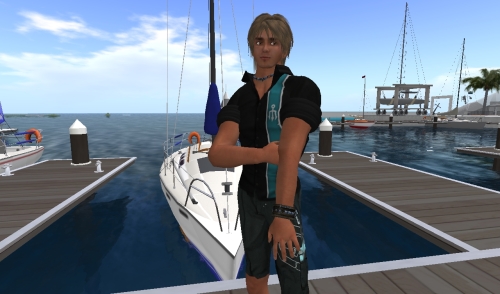



 The
The 








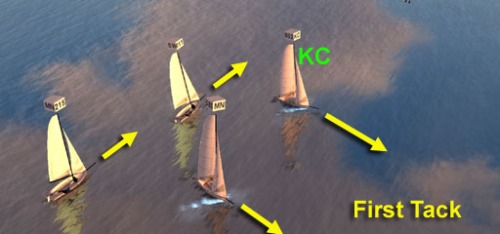


 This time however, Kei had the upwind height and he took advantage of it. He accelerated as he fell off the wind to reach the green buoy, relentlessly widening his lead in the process. The lower picture above gives the false impression that after taking the turn Kei actually became airbourne and took off… Grin; he might just as well have. With “good air” and no other boats in the way, there was nothing on earth to stop Kei, and he showed it.
This time however, Kei had the upwind height and he took advantage of it. He accelerated as he fell off the wind to reach the green buoy, relentlessly widening his lead in the process. The lower picture above gives the false impression that after taking the turn Kei actually became airbourne and took off… Grin; he might just as well have. With “good air” and no other boats in the way, there was nothing on earth to stop Kei, and he showed it.


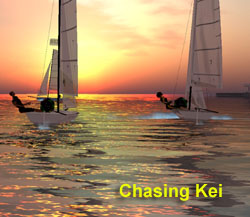








 joro Aya: Makes me feel nervous and uneasy. I entered the cup not expecting much and now… Now Ikinda feel Ihave to do good. It’s still fun though
joro Aya: Makes me feel nervous and uneasy. I entered the cup not expecting much and now… Now Ikinda feel Ihave to do good. It’s still fun though



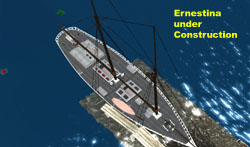 For sometime however, the boat had been in dry dock in Boothbay, Maine, getting essential repairs to its forehull and topsides. Historically accurate, skilled repairs to a venerable schooner like Ernestina are neither easy nor cheap; the costs totaled over $1 million (that’s USD, not $L), and for a while the future of this precious landmark as a sailing vessel was in doubt.
For sometime however, the boat had been in dry dock in Boothbay, Maine, getting essential repairs to its forehull and topsides. Historically accurate, skilled repairs to a venerable schooner like Ernestina are neither easy nor cheap; the costs totaled over $1 million (that’s USD, not $L), and for a while the future of this precious landmark as a sailing vessel was in doubt.
 Continuing the overlap between RL and SL sailing, RJ showed off his Ernestina recreation at the 2008 Boat Show in Second Life the same month he showcased it at the RL New York Boat Show. The Ernestina was a major hit, revealing a truly remarkable level of detail and authenticity. It was maritime history come alive again… it was Ernestina preserved and accessible to all through Second Life.
Continuing the overlap between RL and SL sailing, RJ showed off his Ernestina recreation at the 2008 Boat Show in Second Life the same month he showcased it at the RL New York Boat Show. The Ernestina was a major hit, revealing a truly remarkable level of detail and authenticity. It was maritime history come alive again… it was Ernestina preserved and accessible to all through Second Life. Through a series of public grants and private donations, the extensive repairs on the Ernestina were finally completed recently. This month the venerable schooner at long last returned to its home port in New Bedford, sailing the considerable distance from Boothbay under its own power. But please, don’t think it’s going to become a relic and just sit there quietly! On May 10th Ernestina pulled into Boston’s Rowe’s Warf for the day, just across from — and thumbing it’s nose at — the Volvo Ocean Race Fleet on Fan Pier!
Through a series of public grants and private donations, the extensive repairs on the Ernestina were finally completed recently. This month the venerable schooner at long last returned to its home port in New Bedford, sailing the considerable distance from Boothbay under its own power. But please, don’t think it’s going to become a relic and just sit there quietly! On May 10th Ernestina pulled into Boston’s Rowe’s Warf for the day, just across from — and thumbing it’s nose at — the Volvo Ocean Race Fleet on Fan Pier!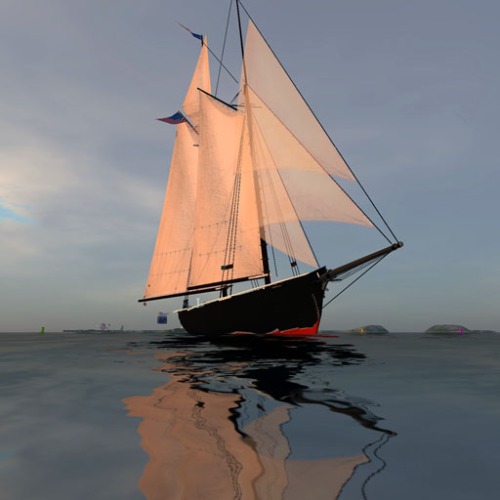
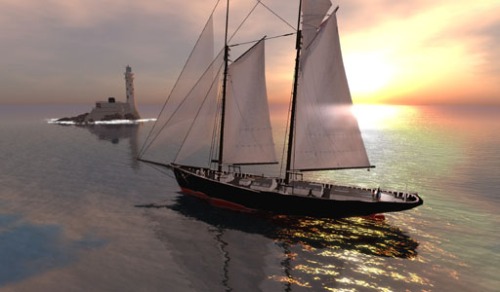



















 Beta Crash Test Team
Beta Crash Test Team
 Bunnie Mills designed the sails; contact her in Second Life if you want custom sails; if you want custom work done on the hull and rigging, you may find a boatwright
Bunnie Mills designed the sails; contact her in Second Life if you want custom sails; if you want custom work done on the hull and rigging, you may find a boatwright 







 The excitement over this year’s Fizz Cup has been pretty electric in recent weeks, and the registration for the competition broke all past records for a sailing event; over the next several weeks 60 sailors will compete with each other in the initial series of qualifying races hosted by many of the Second Life yacht clubs. Those skippers that emerge victorious from that grueling ordeal will then face each other in “Silver” or “Gold” final rounds that will determine which sailors take home the cup for 2009.
The excitement over this year’s Fizz Cup has been pretty electric in recent weeks, and the registration for the competition broke all past records for a sailing event; over the next several weeks 60 sailors will compete with each other in the initial series of qualifying races hosted by many of the Second Life yacht clubs. Those skippers that emerge victorious from that grueling ordeal will then face each other in “Silver” or “Gold” final rounds that will determine which sailors take home the cup for 2009. Having said that, as I watched the Cup 2008 races and tried to reconstruct the tactics employed by the many skippers, I was impressed that Fizz2 still had a ways to go before it accurately modelled small boat racing. Many of the strategies skippers used in the competition were not RL race strategies. Sailors often chose tactics that played off the unique features of the new boat, or exploited “bugs” to enhance their performance rather than focus on sailing skills. The most obvious demonstration of this point occurred early in the series, when it became clear that a number of sailors were legally using a design glitch (pumping the tiller) to go faster. Moth fixed the problem and upgraded all the skippers in the middle of the race series.
Having said that, as I watched the Cup 2008 races and tried to reconstruct the tactics employed by the many skippers, I was impressed that Fizz2 still had a ways to go before it accurately modelled small boat racing. Many of the strategies skippers used in the competition were not RL race strategies. Sailors often chose tactics that played off the unique features of the new boat, or exploited “bugs” to enhance their performance rather than focus on sailing skills. The most obvious demonstration of this point occurred early in the series, when it became clear that a number of sailors were legally using a design glitch (pumping the tiller) to go faster. Moth fixed the problem and upgraded all the skippers in the middle of the race series. 








 I’m impressed that over a year ago there were numerous discussions of racing rules involving many sailors. It was “a hot topic.” These days however, fewer sailors spend time focusing on rules issues, and my guess is most sailors are sort of happy with that. The nuances of racing rules might seem pretty dry and boring to some sailors, akin to interpreting the Talmud. (Private note to Armchair: I’ll explain the Talmudic Race Rules later…)
I’m impressed that over a year ago there were numerous discussions of racing rules involving many sailors. It was “a hot topic.” These days however, fewer sailors spend time focusing on rules issues, and my guess is most sailors are sort of happy with that. The nuances of racing rules might seem pretty dry and boring to some sailors, akin to interpreting the Talmud. (Private note to Armchair: I’ll explain the Talmudic Race Rules later…)



